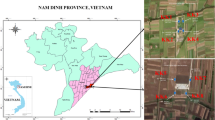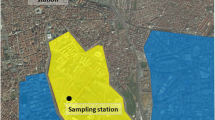Abstract
Due to the subtle occurrence of environmental polycyclic aromatic hydrocarbon (PAHs) pollution from incinerators, it is seldom considered a significant source of PAH pollution. However, considering the recent build-up of toxics in urban air, this may be a serious concern around the incinerator vicinity due to the potential consequences of PAHs on human health. Hence, this study determined 11 alkyl-naphthalene contributions from a hospital waste incinerator (HWI_0) into ambient air receptor points (HWI_1 to HWI_5) for a 1-year period: June 2014–May 2015. The HWI_0 and ambient gases were sampled using filter-sorbent sampling system and polyurethane foam (PUF) passive samplers, respectively, and all alkyl-naphthalenes were determined using GC-MS. Results showed that the source concentrations were in the range of 0–14.0 ng/m3 and generally higher than the receptor points. The receptor point concentration trends were mainly HWI_1 > HWI_2 ≥ HWI_3 ≥ HWI_5 ≥ HWI_4. Multivariate receptor model analysis suggested high correlations between source and the receptor points though there might be some significant contributions from other emission sources. The average monthly concentrations (∑alkyl-naphthalene) at HWI_0 and the receptors HWI_1, HWI_2, HWI_3, HWI_4 and HWI_5 were 67.4 ± 24.3, 57.9 ± 20.1, 42.8 ± 16.9, 39.7 ± 12.2, 36.5 ± 22.2 and 37.8 ± 15.4 ng/m3, respectively. Though these concentrations were lower than the estimated minimal risk level (MRL) for chronic inhalation exposure to naphthalene and its derivatives 0.003 mg/m3, continuous exposure to these pollutants might result in chronic effects. Finally, this study may be used to evaluate the environmental contribution of alkyl-naphthalenes from typical medical waste incinerator in Nigeria.





Similar content being viewed by others
References
Abdo M, Grumbein S, Chou BJ, Herbert R (2001) Toxicity and carcinogenicity study in F344 rats following 2 years of whole-body exposure to naphthalene vapors. Inhal Toxicol 13:931–950
Anyakora CA, Ogbeche KA, Palmer P, Coker H, Ukpo G, Ogah C (2004) A screen for benzo(a)pyrene, a carcinogen, in the water samples from the Niger Delta region. Nig J Hosp Med 14:288–293
ATSDR (1995) Toxicological profile for polycyclic aromatic hydrocarbons (PAHs). http://www.atsdr.cdc.gov/toxprofiles/tp69.pdf
ATSDR (2005) Toxicological profile for naphthalene, 1-methylnaphthalene, and 2-methylnaphthalene. Agency for Toxic Substances and Disease Registry pp 1–347. https://www.atsdr.cdc.gov/substances/toxsubstance.asp?toxid=43
Baraniecka J, Pyrzynska K, Szewczynska M, Posniak M, Dobrzynska E (2010) Emission of polycyclic aromatic hydrocarbons from selected processes in steelworks. J Hazard Mater 183:111–115
Dabestani R, Lvanov IN (1999) A compilation of physical, spectroscopic and photophysical properties of polycyclic aromatic hydrocarbons. Photochem Photobiol 70:10–34
Diagboya PN, Olu-Owolabi BI, Adebowale KO (2016) Distribution and interactions of pentachlorophenol in soils: the roles of soil iron oxides and organic matter. J Contam Hydrol 191:99–106
El-Shahawi MS, Hamza A, Bashammakh AS, Al-Saggaf WT (2010) An overview on the accumulation, distribution, transformations, toxicity and analytical methods for the monitoring of persistent organic pollutants. Talanta 80:1587–1597
Gao L, Zhang Q, Liu L, Li C, Wang Y (2014) Spatial and seasonal distributions of polychlorinated dibenzo-p-dioxins and dibenzofurans and polychlorinated biphenyls around a municipal solid waste incinerator, determined using polyurethane foam passive air samplers. Chemosphere 114:317–326
Hoyos A, Cobo M, Aristizabal B, Cordoba F, de Correa CM (2008) Total suspended particulate (TSP), polychlorinated dibenzodioxin (PCDD) and polychlorinated dibenzofuran (PCDF) emissions from medical waste incinerators in Antioquia, Colombia. Chemosphere 73:137–142
Hu J, Zheng M, Liu W, Li C, Nie Z, Liu G, Zhang B, Xiao K, Gao L (2013) Characterization of polychlorinated naphthalenes in stack gas emissions from waste incinerators. Environ Sci Pollut Res 20:2905–2911
Jambu M (1991) Exploratory and multivariate data analysis. Academic Press, Boston
Landrum PF, Giesy JP, Oris JT, Allred PM (1987) Photoinduced toxicity of polycyclic aromatic hydrocarbons to aquatic organisms. Oil in freshwater: chemistry, biology, countermeasure technology. Pergamon Press, Elmsford, p 304oe318
Lee WS, Chang-Chien GP, Wang LC, Lee WJ, Tsai PJ, Wu KY, Lin C (2004) Source identification of PCDD/fs for various atmospheric environments in a highly industrialized city. Environ Sci Technol 38:4937–4944
Liu G, Cai Z, Zheng M (2014) Sources of unintentionally produced polychlorinated naphthalenes. Chemosphere 94:1–12
Musat F, Galushko A, Jacob J, Widdel F, Kube M, Reinhardt R, Wilkes H, Schink B, Rabus R (2009) Anaerobic degradation of naphthalene and 2-methylnaphthalene by strains of marine sulfate-reducing bacteria. Environ Microbiol 11:209–219
NTP (2000) Toxicology and carcinogenesis studies of naphthalene (CAS No. 91-20-3) in F344/N rats (inhalation studies). National Toxicology Program. NTP TR 500, NIH Publ. No. 01-4434
Olu-Owolabi BI, Diagboya PN, Adebowale KO (2014) Evaluation of pyrene sorption-desorption on tropical soils. J Environ Manag 137:1–9
Olu-Owolabi BI, Diagboya PN, Adebowale KO (2015) Sorption and desorption of fluorene on five tropical soils from different climes. Geoderma 239-240:179–185
Olu-Owolabi BI, Diagboya PN, Okoli PC, Adebowale KO (2016) Sorption behaviour of pentachlorophenol in sub-Saharan tropical soils: soil types sorption dynamics. Environ Earth Sci 75:1494
Park S-U, Kim J-G, Jeong M-J, Song B-J (2011) Source identification of atmospheric polycyclic aromatic hydrocarbons in industrial complex using diagnostic ratios and multivariate factor analysis. Arch Environ Contam Toxicol 60:576–589
Pozo K, Harner T, Shoeib M, Urrutia R, Barra R, Parra O (2004) Passive-sampler derived air concentrations of persistent organic pollutants on a north–south transect in Chile. Environ Sci Technol 65:29–37
Srogi K (2007) Monitoring of environmental exposure to polycyclic aromatic hydrocarbons: a review. Environ Chem Lett 5:169–195
USEPA (2007) Treatment technologies for site cleanup: Annual Status Report (ASR). Twelfth Edition. (EPA 542-R- 07-012)
Wang MS, Wang LC, Chang-Chien GP, Lin LF (2005) Characterization of polychlorinated dibenzo-p-dioxins and dibenzofurans in the stack flue gas of a municipal solid waste incinerator, in the ambient and in the banyan leaf. Aerosol Air Qual Res 37:171–184
Wang G, Huang L, Zhao X, Niu H, Dai Z (2006) Aliphatic and polycyclic aromatic hydrocarbons of atmospheric aerosols in five locations of Nanjing urban area, China. Atmos Res 81:54–66
Wang J, Chen S, Tian M, Zheng X, Gonzales L, Ohura T, Mai B, Simonich SLM (2012) Inhalation cancer risk associated with exposure to complex polycyclic aromatic hydrocarbon mixtures in an electronic waste and urban area in South China. Environ Sci Technol 46:9745–9752
Zhao L, Zhang F, Hao Z, Wang H (2008) Level of polycyclic aromatic hydrocarbon in different types of hospital waste incinerator ashes. Sci Total Environ 397:24–30
Acknowledgements
We acknowledge the technical support of the Departments of Chemical Engineering and Environmental Health, Obafemi Awolowo University. We also acknowledge the reviewers and critics for their excellent input in making the final manuscript.
Author information
Authors and Affiliations
Corresponding authors
Additional information
Responsible editor: Constantini Samara
Electronic supplementary material
ESM 1
(PDF 633 kb)
Rights and permissions
About this article
Cite this article
Adedayo Adesina, O., Ademola Sonibare, J., Diagboya, P.N. et al. Periodic characterization of alkyl-naphthalenes in stack gas and ambient air around a medical waste incinerator. Environ Sci Pollut Res 24, 21770–21777 (2017). https://doi.org/10.1007/s11356-017-9828-1
Received:
Accepted:
Published:
Issue Date:
DOI: https://doi.org/10.1007/s11356-017-9828-1




